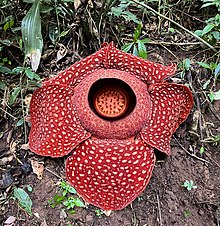
The flora of Borneo include 15 species of dicot tree, 37 species of non-tree dicot and 49 species of monocot endemic to the rich forest of Brunei Darussalam.[1] Borneo is also home to the world's largest flower, the "corpse flower" (Rafflesia arnoldii), which can reach nearly 3 feet (0.91 meters) in diameter and up to 15 pounds (6.8 kg) in weight.[2] Borneo is the third largest island in the world and is divided between three countries: Brunei in the north, the Malaysian constituent states of Sarawak and Sabah, and the 5 Kalimantan provinces of Indonesia[3] (note that in Indonesian, "Kalimantan" refers to the entire island of Borneo).[4]
The tallest tropical trees of the world are in Borneo. They are in the family Dipterocarpaceae.[5]
See also[edit]
References[edit]
- ^ Kamariah A.S, K.M. Wong (1999): "Forests and Trees of Brunei Darussalam", Universiti Brunei Darussalam
- ^ "Floral Giants From Humble Beginnings". Tree of Life : Exhibits : Yale Peabody Museum of Natural History. New Haven, CT, United States: Yale Peabody Museum of Natural History. 2008. Archived from the original on 24 January 2021. Retrieved 5 May 2020.
- ^ "Borneo". Encyclopaedia Britannica. Encyclopaedia Britannica, inc. 30 December 2019. Retrieved 5 May 2020.
- ^ "Kalimantan". Encyclopaedia Britannica. Encyclopaedia Britannica, inc. 24 October 2016. Retrieved 5 May 2020.
- ^ Matt Hamilton, Martin Mészáros, Sabine Holzer (23 May 2021). Borneo – Earth’s Ancient Eden (Television). Vienna: Terra Mater Factual Studios.
Well, that’s interesting to know that Psilotum nudum are known as whisk ferns. Psilotum nudum is the commoner species of the two. While the P. flaccidum is a rare species and is found in the tropical islands. Both the species are usually epiphytic in habit and grow upon tree ferns. These species may also be terrestrial and grow in humus or in the crevices of the rocks.
View the detailed Guide of Psilotum nudum: Detailed Study Of Psilotum Nudum (Whisk Fern), Classification, Anatomy, Reproduction